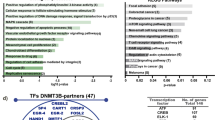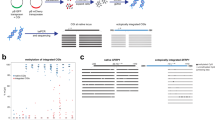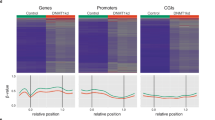Abstract
DNA methylation has a role in the regulation of gene expression during normal mammalian development but can also mediate epigenetic silencing of CpG island genes in cancer and other diseases. Many individual genes (including tumor suppressors) have been shown to undergo de novo methylation in specific tumor types, but the biological logic inherent in this process is not understood. To decipher this mechanism, we have adopted a new approach for detecting CpG island DNA methylation that can be used together with microarray technology. Genome-wide analysis by this technique demonstrated that tumor-specific methylated genes belong to distinct functional categories, have common sequence motifs in their promoters and are found in clusters on chromosomes. In addition, many are already repressed in normal cells. These results are consistent with the hypothesis that cancer-related de novo methylation may come about through an instructive mechanism.
This is a preview of subscription content, access via your institution
Access options
Subscribe to this journal
Receive 12 print issues and online access
$209.00 per year
only $17.42 per issue
Buy this article
- Purchase on Springer Link
- Instant access to full article PDF
Prices may be subject to local taxes which are calculated during checkout




Similar content being viewed by others
References
Monk, M., Boubelik, M. & Lehnert, S. Temporal and regional changes in DNA methylation in the embryonic, extraembryonic and germ cell lineages during mouse embryo development. Development 99, 371–382 (1987).
Kafri, T. et al. Developmental pattern of gene-specific DNA methylation in the mouse embryo and germline. Genes Dev. 6, 705–714 (1992).
Brandeis, M. et al. Sp1 elements protect a CpG island from de novo methylation. Nature 371, 435–438 (1994).
Macleod, D., Charlton, J., Mullins, J. & Bird, A.P. Sp1 sites in the mouse Aprt gene promoter are required to prevent methylation of the CpG island. Genes Dev. 8, 2282–2292 (1994).
Lock, L.F., Takagi, N. & Martin, G.R. Methylation of the HPRT gene on the inactive X occurs after chromosome inactivation. Cell 48, 39–46 (1987).
Gidekel, S. & Bergman, Y. A unique developmental pattern of Oct-3/4 DNA methylation is controlled by a cis-demodification element. J. Biol. Chem. 277, 34521–34530 (2002).
Robertson, K.D. & Wolffe, A.P. DNA methylation in health and disease. Nat. Rev. Genet. 1, 11–19 (2000).
Baylin, S.B. & Herman, J.G. DNA hypermethylation in tumorigenesis: epigenetics joins genetics. Trends Genet. 16, 168–174 (2000).
Jones, P.A. & Laird, P.W. Cancer epigenetics comes of age. Nat. Genet. 21, 163–167 (1999).
Jones, P.A. & Baylin, S.B. The fundamental role of epigenetic events in cancer. Nat. Rev. Genet. 3, 415–428 (2002).
Costello, J.F. et al. Aberrant CpG-island methylation has non-random and tumour-type-specific patterns. Nat. Genet. 24, 132–138 (2000).
Zardo, G. et al. Integrated genomic and epigenomic analyses pinpoint biallelic gene inactivation in tumors. Nat. Genet. 32, 453–458 (2002).
Yu, L. et al. Global assessment of promoter methylation in a mouse model of cancer identifies ID4 as a putative tumor-suppressor gene in human leukemia. Nat. Genet. 37, 265–274 (2005).
Issa, J.P. CpG island methylator phenotype in cancer. Nat. Rev. Cancer 4, 988–993 (2004).
Chan, A.O. et al. CpG island methylation in aberrant crypt foci of the colorectum. Am. J. Pathol. 160, 1823–1830 (2002).
Toyota, M. et al. Aberrant methylation in gastric cancer associated with the CpG island methylator phenotype. Cancer Res. 59, 5438–5442 (1999).
Ahuja, N. & Issa, J.P. Aging, methylation and cancer. Histol. Histopathol. 15, 835–842 (2000).
Baylin, S. & Bestor, T.H. Altered methylation patterns in cancer cell genomes: cause or consequence? Cancer Cell 1, 299–305 (2002).
Rush, L.J. & Plass, C. Restriction landmark genomic scanning for DNA methylation in cancer: past, present, and future applications. Anal. Biochem. 307, 191–201 (2002).
Smiraglia, D.J. & Plass, C. The study of aberrant methylation in cancer via restriction landmark genomic scanning. Oncogene 21, 5414–5426 (2002).
Weber, M. et al. Chromosome-wide and promoter-specific analyses identify sites of differential DNA methylation in normal and transformed human cells. Nat. Genet. 37, 853–862 (2005).
Mukhopadhyay, R. et al. The binding sites for the chromatin insulator protein CTCF map to DNA methylation-free domains genome-wide. Genome Res. 14, 1594–1602 (2004).
Toyota, M. et al. Identification of differentially methylated sequences in colorectal cancer by methylated CpG island amplification. Cancer Res. 59, 2307–2312 (1999).
Stirzaker, C., Song, J.Z., Davidson, B. & Clark, S.J. Transcriptional gene silencing promotes DNA hypermethylation through a sequential change in chromatin modifications in cancer cells. Cancer Res. 64, 3871–3877 (2004).
Maruyama, R. et al. Aberrant promoter methylation profile of prostate cancers and its relationship to clinicopathological features. Clin. Cancer Res. 8, 514–519 (2002).
Odom, D.T. et al. Control of pancreas and liver gene expression by HNF transcription factors. Science 303, 1378–1381 (2004).
Suzuki, H. et al. A genomic screen for genes upregulated by demethylation and histone deacetylase inhibition in human colorectal cancer. Nat. Genet. 31, 141–149 (2002).
Segal, E., Yelensky, R. & Koller, D. Genome-wide discovery of transcriptional modules from DNA sequence and gene expression. Bioinformatics 19 (Suppl.), i273–i282 (2003).
Su, A.I. et al. A gene atlas of the mouse and human protein-encoding transcriptomes. Proc. Natl. Acad. Sci. USA 101, 6062–6067 (2004).
Notterman, D.A., Alon, U., Sierk, A.J. & Levine, A.J. Transcriptional gene expression profiles of colorectal adenoma, adenocarcinoma, and normal tissue examined by oligonucleotide arrays. Cancer Res. 61, 3124–3130 (2001).
Esteller, M. et al. DNA methylation patterns in hereditary human cancers mimic sporadic tumorigenesis. Hum. Mol. Genet. 10, 3001–3007 (2001).
Di Croce, L. et al. Methyltransferase recruitment and DNA hypermethylation of target promoters by an oncogenic transcription factor. Science 295, 1079–1082 (2002).
Feltus, F.A., Lee, E.K., Costello, J.F., Plass, C. & Vertino, P.M. Predicting aberrant CpG island methylation. Proc. Natl. Acad. Sci. USA 100, 12253–12258 (2003).
Varambally, S. et al. The polycomb group protein EZH2 is involved in progression of prostate cancer. Nature 419, 624–629 (2002).
Cao, R. & Zhang, Y. The functions of E(Z)/EZH2-mediated methylation of lysine 27 in histone H3. Curr. Opin. Genet. Dev. 14, 155–164 (2004).
Plath, K. et al. Role of histone H3 lysine 27 methylation in X inactivation. Science 300, 131–135 (2003).
Silva, J. et al. Establishment of histone H3 methylation on the inactive X chromosome requires transient recruitment of Eed-Enx1 polycomb group complexes. Dev. Cell 4, 481–495 (2003).
Vire, E. et al. The Polycomb group protein EZH2 directly controls DNA methylation. Nature advance online publication 14 December 2005 (10.1038/nature04431).
Eden, S., Hashimshony, T., Keshet, I., Thorne, A.W. & Cedar, H. DNA methylation models histone acetylation. Nature 394, 842–843 (1998).
Acknowledgements
Colon biopsies were provided by J. Zimmerman. We thank R. Rubinstein and M. Kott for help in the computer and microarray analyses. This research was supported by grants from the Rosetrees Trust, the US National Institutes of Health, the Israel Cancer Research Fund, the Belfer Foundation, the Conquer Fragile X Foundation, the Prostate Cancer Foundation, Fondation pour la Recherche Medicale-Ligue Nationale Francaise Contre le Cancer, Association for International Cancer Research (AICR) and the Bikura program of the Israel Science Foundation.
Author information
Authors and Affiliations
Corresponding author
Ethics declarations
Competing interests
The authors declare no competing financial interests.
Supplementary information
Supplementary Fig. 1
Sensitivity of microarray mDIP for detecting DNA methylation. (PDF 285 kb)
Supplementary Fig. 2
Bisulfite analysis of methylated genes. (PDF 1060 kb)
Supplementary Table 1
Methylated genes previously reported. (PDF 56 kb)
Supplementary Table 2
Methylated gene characteristics. (PDF 57 kb)
Supplementary Table 3
Functional categories of methylated genes. (PDF 73 kb)
Supplementary Table 4
mDIP microarray data. (PDF 7514 kb)
Rights and permissions
About this article
Cite this article
Keshet, I., Schlesinger, Y., Farkash, S. et al. Evidence for an instructive mechanism of de novo methylation in cancer cells. Nat Genet 38, 149–153 (2006). https://doi.org/10.1038/ng1719
Published:
Issue Date:
DOI: https://doi.org/10.1038/ng1719
This article is cited by
-
A DNA methylation signature for the prediction of tumour recurrence in stage II colorectal cancer
British Journal of Cancer (2023)
-
CD4 expression in effector T cells depends on DNA demethylation over a developmentally established stimulus-responsive element
Nature Communications (2022)
-
Regulation of impulsive and aggressive behaviours by a novel lncRNA
Molecular Psychiatry (2021)
-
CDH2/N-cadherin and early diagnosis of invasion in patients with ductal carcinoma in situ
Breast Cancer Research and Treatment (2020)
-
FGF5 methylation is a sensitivity marker of esophageal squamous cell carcinoma to definitive chemoradiotherapy
Scientific Reports (2019)



